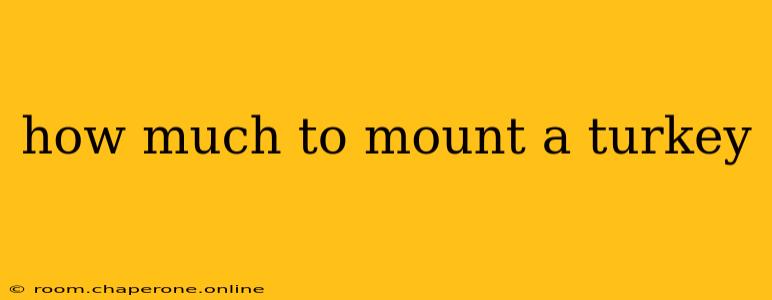Mounting a turkey, whether a prized trophy from a successful hunt or a cherished pet, is a process that preserves a cherished memory. However, the cost can vary significantly depending on several factors. This guide breaks down the price components and helps you understand what to expect when budgeting for your turkey mount.
Factors Affecting the Cost of Turkey Mounting
Several key factors influence the final cost of your turkey mount. Understanding these will help you get a more accurate estimate and avoid unpleasant surprises.
1. Taxidermist Experience and Reputation:
This is arguably the biggest factor. Experienced, highly-skilled taxidermists with a strong reputation often charge more. Their expertise guarantees a higher-quality, more lifelike mount. Conversely, less experienced taxidermists may offer lower prices, but the quality of the finished product might suffer. Researching local taxidermists and reviewing their portfolios is crucial. Look for online reviews and check out their past work – are the poses natural? Does the plumage look realistic?
2. Type of Mount:
The type of mount you choose directly impacts the cost. A simple shoulder mount, showing the head, neck, and upper body, is generally the most affordable option. A full-body mount, capturing the entire bird, is considerably more expensive due to the increased labor and materials involved. Other specialized mounts, such as a flying turkey mount or a unique pose, will also command higher prices.
3. Size and Condition of the Turkey:
Larger turkeys require more work and materials, driving up the cost. The condition of the turkey upon delivery also plays a crucial role. A bird in poor condition, requiring extensive repair or restoration, will increase the final price. Proper care and preparation before taking your turkey to the taxidermist are vital to minimizing extra costs. Remember to follow your taxidermist's specific instructions for prepping the bird.
4. Location and Geographic Factors:
The cost of living in your area directly affects pricing. Taxidermists in high-cost areas will typically charge more than those in less expensive regions.
5. Additional Services:
Some taxidermists offer additional services that increase the overall cost. This might include:
- Custom bases: Choosing a specific base material or design (e.g., a natural wood base versus a simple plaque) will add to the expense.
- Special poses: Complex or unusual poses requiring more time and skill naturally cost more.
- Scene mounts: Incorporating a diorama or natural background into the mount adds significant complexity and expense.
Cost Estimates: What to Expect
While precise pricing is impossible without consulting local taxidermists, here's a general idea of the cost ranges:
- Shoulder Mount: $300 - $800
- Full-Body Mount: $800 - $1500+
- Life-Size Mounts or Highly Detailed Scene Mounts: $1500+
These are broad estimates, and the actual cost could fall outside these ranges depending on the factors listed above.
Finding the Right Taxidermist
Thorough research is vital to finding a reputable taxidermist who meets your needs and budget. Consider these steps:
- Ask for referrals: Contact hunting groups or outdoors enthusiasts for recommendations.
- Check online reviews: Search for online reviews and testimonials to assess the taxidermist’s reputation and quality of work.
- Review portfolios: Examine the taxidermist's portfolio to see examples of their previous work.
- Get multiple quotes: Obtain quotes from several taxidermists to compare prices and services.
- Discuss expectations: Clearly communicate your vision for the mount and any specific requests to ensure the taxidermist understands your needs.
Mounting a turkey is an investment that preserves a lasting memory. By understanding the factors that influence the cost and taking the time to find a skilled and reputable taxidermist, you can ensure that your treasured trophy receives the respect and craftsmanship it deserves. Remember to discuss all aspects of the project and the associated costs upfront before proceeding.

